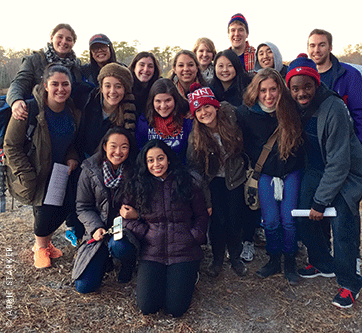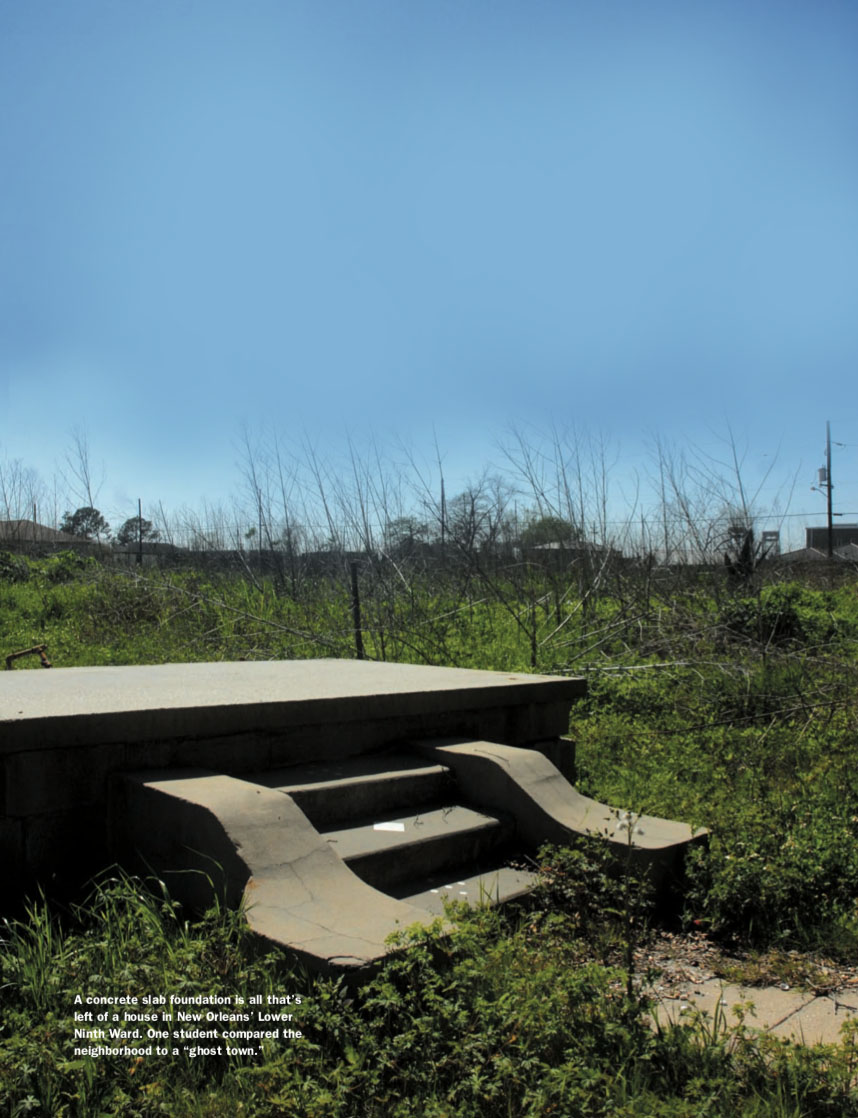
Three years after Hurricane Katrina, recovery is far from complete. Hundreds of students and faculty from schools across Penn are volunteering in New Orleans and the Gulf Coast in what may be the largest university-based relief effort from outside the immediate region.
By Samuel Hughes | Photography by David Rae Morris and FLINOLA
Sidebars | “Please Stand Up” and Place Matters
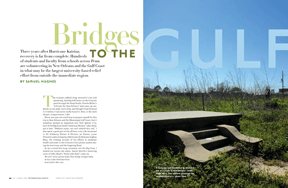
The trumpet sobbed—long, mournful cries and sputtering, bawling half-notes—as the Crescent sped through the Deep South. Charlie Miller’s “A Prayer for New Orleans” had come up randomly on my older son’s iPod, and though I had listened to it before, I had never really heard it. Now, in the dark sleeper compartment, I did.
Music was just one small way to prepare myself for this trip to New Orleans and the Mississippi Gulf Coast, but it somehow seemed an important one. Nick Spitzer C’72, host of the Big Easy-based “American Routes” radio show, put it best: “Without music, we can’t rebuild this city.” I also spent a good part of the 28-hour train ride immersed in No Ordinary Heroes: 8 Doctors, 30 Nurses, 7,000 Prisoners and a Category 5 Hurricane, by Demaree Inglese M’92, the riveting account of his efforts to maintain health and order in the Crescent City’s prison system during the hurricane and the lingering flood.
As we crossed the long causeway into the Big Easy, I looked out across the water. Aaron Neville’s haunting cover of John Hiatt’s “Feels Like Rain” came on:
We ain’t never gonna make that bridge tonight baby
Across Lake Pontchartrain
And it feels like rain.
Are you aware of the extent of Penn’s efforts in the Gulf?” Dr. Richard Gelles, dean of the School of Social Policy and Practice (SP2), had asked me. At the time, I wasn’t. That was back in January, and while I knew that some student groups were doing volunteer work in New Orleans, I had no idea how many, or how wide they had cast their net.
As it happened, my wife, Pat, and I had been talking about taking our two teenage sons, Tristan and Jesse, to New Orleans during their spring break for some Katrina recovery work and maybe a bon tempor two. Volunteer work, we thought, would be good medicine for all of us, especially the Privileged Teens. But we were still dithering when the dean tracked me down.
“The University has probably the largest footprint in the Gulf of any university outside the immediate region,” began Gelles, who then swung into a discussion of the Fox Leadership Program’s efforts and the Center for Urban Redevelopment Excellence (CUREx) program, both in New Orleans, before moving to the Feldman Initiative in Hancock County, Mississippi, in which SP2 has played the lead role. When he started talking about the work being done by his MSW students and those from the dental and nursing and engineering schools—all of whom had rolled up their sleeves, gotten their hands dirty, hung out in places like Turtle Landing, and stayed in the local recovery center—a light went on. Sounded like a story—maybe more than one.
He saw the bulb glowing over my head. “It’s a life-changing experience,” he said, eyebrows arching enigmatically.
A few days later Connie Hoe SW’07, the indefatigable coordinator of the Feldman Initiative, informed me that we were booked into the Pearlington Recovery Center for five nights. Bring your own sleeping bags, work gloves, and bug dope, she said.
Trying to keep track of all the different Penn groups in the Gulf can be a full-time job. The largest contingent falls under the heading of Penn UNO—Penn Undergraduates in New Orleans, which sent some 200 undergraduates to the Crescent City over spring break this year. Most worked with Habitat for Humanity and Helping Hands, doing basic construction and grunt work. They stayed in Camp Hope, a barracks-like former school in St. Bernard Parish, half an hour southeast of the city.
Penn UNO’s largest segment is the Fox Leadership Program—FLINOLA: Fox Leadership in New Orleans, Louisiana—which sent 100 undergraduates there for a week this past March and is now sponsoring 15 students in 10-week summer internships. Other groups include MAJIC (Muslims and Jews in Cahoots), Civic House, Campus Crusade for Christ, the Newman Center, and Communitech, a technology-assistance program sponsored by the School of Engineering and Applied Science.
Not all students are undergrads: CUREx, based in the School of Design and funded by the Rockefeller Foundation, sent 21 master’s candidates in city and regional planning as interns in March to assist the Rockefeller fellows planted in various redevelopment agencies in New Orleans. The Feldman Initiative—which is putting its shoulder to the wheel in Hancock County—has been spearheaded by SP2 master’s candidates and includes students and faculty from the dental, engineering, and nursing schools. Nor is it just students: Last month 25 faculty and staff spent a week in June on a Habitat for Humanity project in St. Bernard Parish.
It’s an intense commitment for a university based more than a thousand miles away. But then, the whole notion of engagement—that a great American university should “engage dynamically with communities all over the world to advance the central values of democracy and to exchange knowledge that improves quality of life for all”—is a key element of President Amy Gutmann’s Penn Compact.
“It was clear that what we stood for was putting our knowledge into practice,” said Gutmann in a recent interview, “and if there ever was a case of engaging as an institution, this was one where we wanted to be leaders, not followers.”
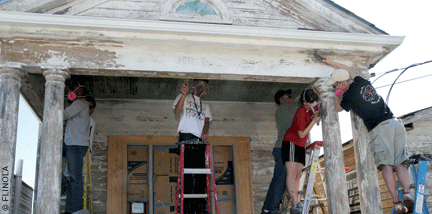
Rebuilding the Land of Dreams
“We talk about this ‘united America,’ especially post-9/11,” Judith Kim C’09 was saying. “Nine/eleven was certainly a test of our resolve. But this is a greater test than that. It revealed a lot of problems that just can’t be solved very quickly and simply. People are saying it will take 10 years for the city to recover. What kind of greater test is there—when you don’t live in New Orleans, and you come down to help the city anyway because you’re an American?”
Kim was sitting in a conference room in Leadership Hall (a wing of the old Fels mansion given over to the Fox Leadership Program), flanked by Dr. John DiIulio C/G’80, the Fox Leadership Professor and the program’s faculty director, and Joe Tierney, its executive director. She is just one of several hundred Penn students who have invested substantial time and sweat equity in the Crescent City since Hurricane Katrina smashed through the levees in 2005. Many of them have been there multiple times; some are there now. And many of them are planning to go back. Again, and again.
“This is a Gettysburg moment,” says DiIulio. “It’s a test of our national character. It’s about the loss of a great American city, many of whose citizens are poor. The question is: Are we going to have a one-month response, or are we going to take full civic and moral responsibility to educate our students for citizenship, per Ben Franklin?”
On September 12, 2005, two weeks after Katrina hit New Orleans, while the toxic flood waters still lapped at second-story windows, Marc Morial C’80 addressed several hundred students, faculty, and staff in Irvine Auditorium. Many in the audience were freshmen who had barely unpacked their suitcases.
Morial’s roots run deep in the Crescent City. He served as its mayor from 1994 to 2002, following in the footsteps of his father, the late Ernest Morial. Now president of the National Urban League and co-director of the Fox Advisory Group at Penn, he urged the students to volunteer their “time, talent, and treasure,” adding somberly: “there are long-range issues that Hurricane Katrina will rightfully force the nation to deal with.”
The students heard him.
“They instantly got it,” says DiIulio. “I’ve never seen anything like it. The undergraduate interest in this was incredible. Kids were talking about Penn’s role in the recovery process and the academic programs that might be developed. It was a very thoughtful, sophisticated, and frankly inspiring response.
“The bottom line is, we made a commitment to Marc and to the students in about a dozen follow-up meetings,” he adds. “We said, ‘We don’t have the answer’—I’m a ‘light a single candle’ guy, but I don’t pretend to be the electric company. But thanks to Bob and Penny Fox, we do have financial resources, ideals, and inspirations.”
New Orleans was hardly a sexy destination even after the bloated bodies had been fished out and the fetid waters had dried up and a semblance of order had been restored. (For more on what it was like there then, see Nick Spitzer’s “Exile from the Land of Dreams” in the Jan|Feb 2006 issue). At that time 75 percent of the city’s pre-Katrina population were still exiled in places like Houston and Atlanta and Baton Rouge. Nearly 200,000 houses and 17,000 businesses had been destroyed; many more were badly damaged. To say that the city’s future was in doubt was putting it mildly.
The Fox Leadership Program began planning for a spring-break service trip (“Don’t Take a Break from Leadership”) shortly after Morial’s first talk in Irvine. About 100 Penn students heeded the call and traveled to the Gulf the following March, including representatives from Campus Crusade for Christ, Civic House, and Hillel. (Students from the Newman Center went to Gulfport and Biloxi, while others from the chaplain’s office and the Center for Community Partnerships worked in Lafayette, Louisiana.)
What they saw was beyond shocking. The water had finally receded, but it had left behind a moldering, rotting ghost town, especially in low-lying areas like Lakeview and the Lower Ninth Ward. Cars were strewn about like toys flung by an angry toddler; houses had collapsed or were off their foundations. Most of the students’ work involved gutting the doomed, toxic houses in preparation for demolition.
For most universities outside of the Gulf, the spring and summer after the storm represented the high-water mark of their recovery efforts. For Penn, it was just the beginning—the “spontaneous rallying and sustaining of an effort where other colleges had more or less fallen off,” in DiIulio’s words. The student groups began collaborating—and agitating to do more. “They basically said, ‘It’s not enough, Professor DiIulio. It’s not enough. We have to do more. We have to sustain it. We saw the scale of it.’
“For Penn undergrads, this was not an exercise in self-interest,” their professor adds. “They’ve gone when there was no diversion, when there was no jazz and no Bourbon Street. When you’re committing to 10 weeks in the summer, working in a domestic violence center, or Big Brothers/Big Sisters—that’s 10 weeks of your summer in a place that’s pretty hot. You’re not exactly living high on the hog.”
Judith Kim made her first trip to New Orleans in the spring of 2007, and the first thing she did was take a bus tour, which started in the French Quarter. As part of her preparation, she had watched Spike Lee’s documentary When the Levees Broke in DiIulio’s Religion and U.S. Public Policy class. As a result, she felt a little confused seeing the French Quarter in “such pristine shape,” she recalls. Then they left the French Quarter.
Some neighborhoods, like the Lower Ninth Ward, “made me feel like we were driving through ghost towns—ones I had only seen in movies before the trip,” she says. “Though all the walls of the houses remained, all of the windows were blown out, the insides of the houses only had debris inside, and of course, the big X on the doors with how many people had been found dead inside along with when the house was searched.” In those neighborhoods, “we didn’t see anyone cleaning up or trying to rebuild their homes—it seemed as if everyone had left for good.”
At one point, they stopped at a site in the Lower Ninth. All that was there was a makeshift shelter for a volunteer organization and one house whose remains had not yet been cleared, says Kim. “It was hard to believe that such a lot once held hundreds of houses—more importantly, hundreds of families.”
Since then Kim has been back three times, working for the Salvation Army and Providence Community Housing (a subsidiary of Catholic Charities), and returning again this past March with DiIulio’s Leadership and Democracy course. She’s there now, on a 10-week internship with Providence, one of the 15 sponsored this summer by Fox.
Max Weiss C’11 worked with a dozen other Penn students in the Lower Ninth Ward under the supervision of Habitat for Humanity, building a three-bedroom house for a musician, his wife, his three kids, and his elderly mother.
“I did things that I never thought I would do,” Weiss recalls. “I have a fear of heights, but I was one-to-two stories high on a ladder, nailing a vent to the house. I also crawled under a house and put insulation on the bottom and helped rip an old rusted fence out of the ground.”
The students’ reward came when they got to meet the musician and his elderly mother—who were, not surprisingly, “very appreciative.” The fact that the musician’s kids had been sleeping in a closet “highlighted the importance of what we were doing,” says Weiss, “and all of us worked as hard as we could the rest of the week to get these people in their house.”
Conor Lamb C’06, then a second-year student in the Law School, was the work-site supervisor for the Habitat for Humanity house. Oddly enough, for him, the most valuable aspect of the experience was “the chance to appreciate the size of the problem there as measured by the tiny impact of a week’s worth of volunteer labor.” As proud as his group was of their work hanging baseboards and door frames, “beneath that pride lurked the realization that our contribution had been quite small,” he says. “This was certainly not for lack of effort—each of us was up with the sun every morning and reluctant to quit in the afternoon—and in fact, any uncertainty we experienced about our accomplishment is probably only possible because we worked hard.”
While it would be easy to conclude that the devastation and the high costs of rebuilding make retreat “the only option,” he adds, “I believe that our work, and the work of thousands of volunteers like us, is worth that much more because the problem itself is so massive.”
On the whole, says Joe Tierney: “I’ve never seen a group of Penn students look happier in my life. The smiles on their faces as they were working on the houses—it was really refreshing. Significant numbers want to go back, either in the summer-intern program or for spring break next year. New Orleans gets into your blood.”
The people of New Orleans responded warmly and often with tears to the efforts of volunteers—and to their very presence.
“The literal Latin root of compassion means suffering with,” DiIulio was saying a couple of weeks before the March trip. “There are times in life when you’re not able to solve a problem. It may be a personal life that is suffering, or it may be with respect to the suffering of their own neighborhood or city. But the value of suffering with somebody, in the places that they live, is not nothing.”
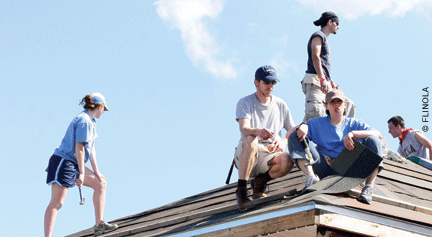
The students also had audiences with some impressive characters, including the Rev. Jerry Kramer, the passionately committed rector of the Episcopal Church of the Annunciation in the Broadmoor neighborhood; Lynn Tinto, a project manager with the Army Corps of Engineers’ Task Force Hope (not to mention the mother of Catherine Broussard C’08); the leadership of Catholic Charities; and Dr. Demaree Inglese, the former medical director of the New Orleans city jail, whose book, No Ordinary Heroes, DiIulio had pressed upon me before my trip to the Gulf.
Toward the end of their stay, Louisiana Lt. Governor Mitch Landrieu spoke to all the Penn students. Calling New Orleans the “classroom of the world”—a deft phrasing for his audience—he described Katrina’s devastation there as an “American drama,” and one in which he was profoundly grateful for the presence of 200 Penn students.
As DiIulio recounts Landrieu’s talk, it’s sometimes hard to know whose words are being spoken, but either way, they pack a powerful punch:
“It’s a battle that has to be won. You’ll tell your children and grandchildren that when it mattered, you refused to go quietly into the night with respect to the loss of a major American city, abandoning people who were poor. That you did what you could, even though others did not, and even though many powerful institutions, public and private, failed—you were there, and you were steadfast.”
Khalid Usmani W’08 is one of the leaders of Muslims and Jews in Cahoots, an interfaith volunteer group that not only wins the clever acronym contest—MAJIC—but is also remarkable for its makeup. This “unlikely union” of Jewish and Muslim students worked on a house in the Lower Ninth and, at the same time, built some metaphorical bridges.
“Most people would think that those groups would be at odds,” he says, “but working together in a teamwork kind of environment towards a common good, one that we both agreed needs attention—maybe that type of mindset could be transferred to other issues geopolitically.”
Usmani recalled a particularly poignant moment when the Muslim and Jewish students, the latter mostly Orthodox, visited a synagogue during Shabbat services. “We had the entire basement area, and were just sitting down there in a round circle. It was an intense moment. We were about to delve into some issues dealing with Islam and Judaism and how it relates to some of the issues in Israel and Palestine, but I felt comfortable still. You’re about to get into something that you don’t like to, but you’re around people that you feel that, if you were to get into something messy, these are the people that you could work it out to some degree, or even agree to disagree.”
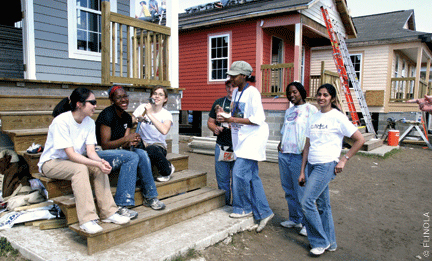
Despite some doubts before the trip began—“Would it just be a repeat of the typical dialogues that we normally have on campus?”—it was “probably the best thing I could have done in my four years here,” he says now. “I learned a lot from just building the friendships and being able to know that there is a way that you can deal with a lot of the major issues.” The bunk beds and barracks-like living quarters brought out the nuances of their different religious backgrounds, he adds, and getting to know each other while working toward a common goal “was very special in a way.”
“We feel like something like this could be replicated—bringing other Penn students here on campus, and also other universities,” he adds. “I think it’s a very unique way to do dialogue in a community-service setting—where everyone agrees that this is the community service that we need to do.”
For President Gutmann, that partnership was a powerful and moving development.
“All of our groups really acted as teams moving forward,” she said in an April interview after viewing an exhibition of photographs depicting the spring-break experiences of Penn’s many community-service projects around the world [“Window,” this issue]. “But in the context of the world, and what’s happening in the world, I think the MAJIC group is truly magical. Because if you think about Muslims and Jews in Cahoots—first of all, it’s not just clever, it shows a kind of spirit of engagement. And secondly, they’re in cahoots in going to New Orleans, you know, so they’re not just in their own back yard, they’re not just thinking about the Middle East; they’re talking about their commonalities and differences in making a difference in their own country. It encapsulates so much of what’s going on.”
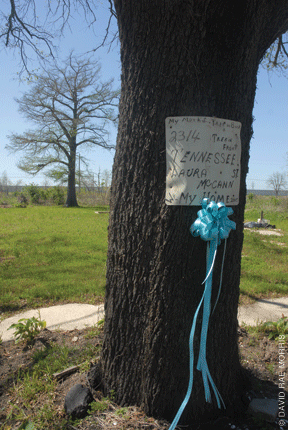
There’s a reason all those songs have been written about New Orleans. It’s not just the blue notes that drift out of so many bars and clubs, or the wrought-iron railings on the French Quarter townhouses, or the muddy majesty of the Mississippi, or the beignets and chicory-laced coffee and oyster po’ boys and crawfish etouffee, or … Whatever it is, it all comes together in an easy gumbo that has long seduced outsiders.
But New Orleans also has long had its full share of problems: a poor school system, high murder rate, municipal corruption, and declining population, to name just a few. Add the devastation wrought by Katrina, and you have a city hanging in the balance.
“Everybody is saying that 2008 is going to be the turning point,” says Caroline Gammill C’07, who handles economic and community-development issues for Providence Community Housing when she’s not coordinating the Fox program’s volunteer activities. “People are going to planning meetings, and there’s a real energy and sense of urgency and a desire to take the plans and put them into action.”
Providence’s current project is to create some 7,000 new or rebuilt housing units—enough to bring 20,000 more residents back into the city. While the city’s population has increased to some 300,000—roughly 65 percent of its pre-Katrina level of 465,000—some neighborhoods, such as the Lower Ninth Ward, are at something like 9 percent of their pre-flood levels. One of the basic tenets of the 394-page Unified New Orleans Plan is that every resident of the city has a right to return home. But at what cost? Is it realistic or advisable to rebuild the entire neighborhood in such a devastated, vulnerable area? Neither the answers nor the debate have been easy.
“There was a lot of absurd talk that every square inch of this town has to come back and everything has to be rebuilt as it was,” says DiIulio. “Well, some of ‘as it was’ wasn’t that great—like the school system. No one in their right mind wants to bring back everything as it was.”
For all the pain it caused, Katrina “gave us an opportunity to rethink, recast, regroup, and reorient ourselves to the civic life of New Orleans,” he adds. “So the hard questions have been asked. The Unified New Orleans Plan is not perfect, but it’s a detailed, thick document. The Brookings Institution has done very good work in the Center of Urban Metropolitan Policy. A number of other groups from outside the region, some of the folks at Tulane in social work and other fields, have asked the right questions and gathered the relevant data.”
While the debate over bringing back the Lower Ninth Ward is a “separate argument,” he adds, “the people deserve to be duly compensated, just as other victims of other storms were compensated where there was government negligence.”
But the larger point for DiIulio is that New Orleans itself is a “viable city given viable infrastructure protection.” There is no question, he adds, that “New Orleans can be as safe as any port city in the world.”
While this may not seem like a controversial statement now, in the immediate aftermath of Katrina, some serious voices—including Dr. Robert Giegengack, the Davidson Kennedy Professor of Earth and Environmental Sciences—argued that the current location of New Orleans is untenable, given the interplay between geological processes and recent human activities along the Mississippi River.
For DiIulio, the notion that New Orleans should not be rebuilt on its historic site ignores the real culprit: the failure of the levees.
“Nobody has any disagreement that it was because the levees failed, and that’s why New Orleans flooded,” he says. “The technical capacity to make that city safe against a Category 3 storm is there.” But because the federal government was “derelict from start to finish—Congress, successive presidential administrations, the Army Corps of Engineers—the people of New Orleans, when the levees failed, paid the price.”
It’s a matter of setting priorities, he adds. “Does anybody really believe that the Big Dig in Boston, which cost tens of billions of dollars, should have had a greater national priority than a place through which flows such a huge fraction of all of the oil and gas, such a huge fraction of the food that sets tables” across the country.
The recovery process has, in some ways, proceeded more quickly than some people feared, but there is still an “ebb and flow” to it, DiIulio notes. “It’s not linear. We have to be prepared for the inevitable setbacks. There’s not going to be any kind of ribbon-cutting.”
But for now, as Gammill says: “There’s a shared commitment to making this work.” Applications to Tulane have reportedly spiked, and the fact that so many young people have chosen to volunteer here speaks volumes about the city’s future.
“It’s not always easy to be here,” Gammill says, “but everybody who’s here wants to be here. Maybe not all day, every day, but there’s a reason everyone wants to return. There’s a pride here and a sense of investment here that’s unlike anything I’ve ever seen.”
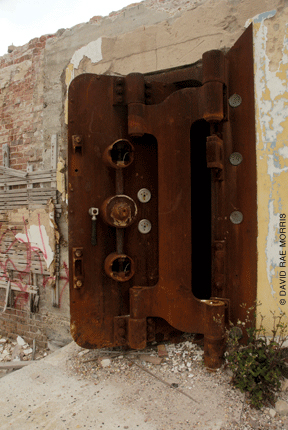
At one point in my interview with President Gutmann, I ask her about the challenges of channeling the passionate enthusiasm of student volunteers into useful activity. Is Penn, I wonder, trying to create a template for that process?
“I have long thought that passion and reason have to be allied, and that one of the characteristics of Penn is that we both recruit and foster passionate involvement in the educational enterprise as well as in community service,” she says. “Is this a template? Yes. I think it’s a characteristic of how you get knowledge put into social service, how you get knowledge put into constructive action. You really have to identify as a human being with the needs and perspectives of other human beings, and then you have to think, as an educated human being, how you can make a positive difference.
“This project, which takes students who might simply go and relax or have a good time on spring break, engages them in something that’s so exciting and so meaningful,” she adds. “That’s a signature model of what Penn’s about. It’s the most meaningful thing we can do to show how education matters.”
Mississippi Rising
If you tracked the flood of Katrina-related images and commentary that overflowed the nation’s news canals, chances are you didn’t hear much about Pearlington, or Bay St. Louis, or Waveland, or any of the other towns and hamlets in Hancock County. The Gulf cities of Biloxi and Gulfport, with their devastated casinos and hotels, made the news, and Pascagoula got a Presidential back-pat when Senator Trent Lott’s oceanfront house was destroyed. But beyond that it was pretty much all New Orleans, all the time—even though there the storm never rose above Category 3.
In Hancock County, some 30-50 miles to the east, Katrina was a Category 5 monster. Its 135-mile-an-hour winds produced a storm surge of nearly 30 feet, not just on the Gulf itself but along the Pearl River that flows into it; the flood waters reached 12 miles inland. The result was like something out of The Day After Tomorrow. People who didn’t evacuate survived by scrambling into the rafters of their homes, sometimes joined by their pets, and clinging to tree branches. Fifty-one people died, and thousands lost their homes. Sealed coffins washed up onto lawns. For the next 48 hours, the county’s only link to the outside world was WQRZ-FM, the low-power community radio station that founder/manager/hero Brice Phillips managed to disassemble at his doomed studio in Bay St. Louis and reassemble in a cinderblock building by the county courthouse. It was five days before the first military helicopters even showed up, and 10 before any real help arrived. It took a couple of months to get electricity. Drinking water, from the relatively shallow wells, now smelled nasty, and nobody knew how potable it was. Homeowners who had insurance were discovering that they would not be reimbursed for damage to their homes.
By then the word was getting out and the volunteers were coming in, some more helpful than others. The Red Cross, which had been feeding large numbers of locals, now found itself feeding large numbers of outsiders. Most were connected with churches or other faith-based groups, though an adjective-defying group called Burning Man soon arrived to help tear down ruined structures and build new ones (not to mention create a new Welcome to Pearlington sign carved out of flood detritus). Among the Burning Men was a New England-based contractor named Bob Putnam, who gave up his lucrative construction business to help rebuild the ruined Gulf Coast—first in Biloxi, then in Pearlington. When Burning Man pulled out, Putnam stayed behind and became the volunteer coordinator for the Pearlington Recovery Center, which took over the flooded elementary school and its adjacent gymnasium. Larry Randall and Herb Ritchie, Pearlington residents, were co-directors.
“The Pearlington Recovery Center is the nucleus of what’s happening down here,” says Putnam. “They did everything from distribute food to seeing that the elderly and disabled were taken care of.” The center also ran interference for residents who needed a FEMA trailer.
The recovery was under way. But the hard part was just beginning.
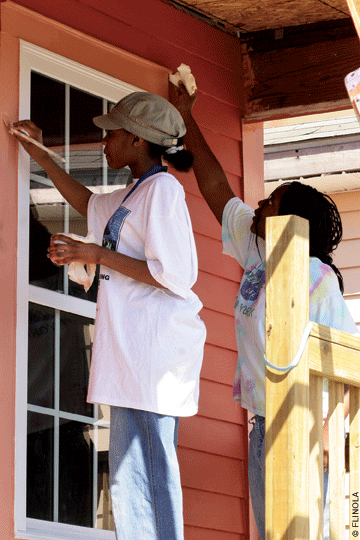
Dean Gelles and Feldman Initiative project-coordinator Connie Hoe are sitting in the lobby of the Hyatt New Orleans. They and 15 SP2 students have dropped in to tell stories about their stint there over spring break, which has just ended. Gelles may grumble about being “too old for this stuff”—he bunked in the recovery center along with the students after staying till closing time at Turtle Landing (the Pearlington beer-and-po’ boy joint)—but there’s a certain pride in his kvetching.
Now he’s talking about how he and SP2 and the Feldman Initiative ended up in Hancock County. It boils down to timing and serendipity.
“With a disaster of this magnitude, once the immediate crisis is over and people are fed and have a roof over their head and the potential of violence decreases, the public eye will begin to turn away and leave them to their own resources,” Gelles says. “That’s when the mental-health issues will begin to set in. So I told our students, ‘When your expertise is needed, we’ll find something. But your expertise is not mucking out houses or building houses. You’re mental-health professionals, social-service professionals.’”
Then, at a conference on children at risk, he met the late William Eastburn L’57, a Doylestown, Pennsylvania-based lawyer and philanthropist who had seen the devastation in Hancock County and co-founded the Bucks-Mont Katrina Relief Project to help. Bucks-Mont built and administered a badly needed day-care facility in Waveland, one of the hardest-hit communities in the county, and under the guidance of another volunteer lawyer, Maureen Gatto, it continues to do yeoman work in the region.
Bucks-Mont’s work in Hancock County resonated with Gelles, who dispatched Connie Hoe and Malik Cooper SW’07 to assess the possibilities. Of all the towns they visited, Pearlington—where every house had either been destroyed or rendered temporarily uninhabitable—made the deepest impression. It’s a “census-designated place,” meaning it has no municipal government of its own, and consequently was often ignored by the county even in the best of times.
“After we got there, I knew we had to be there,” says Hoe. “It’s a poor town in a poor county, with a lot of minorities and a blatant need of resources. A lot of the houses were still uninhabitable. About half the people were still living in [FEMA] trailers. After seeing all the needs they still had, two years later, I decided I couldn’t leave.”
“It was clear that the residents at least wanted people to know they had needs,” says Gelles. “When I talked to people up North, they thought everything was fine. It’s not fine.”
“It’s easy for people to forget about the intangibles,” points out Hoe. “The social fabric was destroyed. The entire mental-health and social-service system was destroyed. And mental health is something that’s invisible to the eye.”
This past January, Hoe led 32 volunteers from the four schools—SP2, dental, nursing, and engineering—to Pearlington. “From the beginning, the dean wanted to make this an interdisciplinary effort,” she says. They began by organizing a health fair, with the help of a moderator from the University of Southern Mississippi. Some 300 people showed up, an impressive turnout for such a small community—testimony both to the needs of the residents and to the organizing skills of the SP2 students.
About half the residents came for the free dental exams, “which was about double what was expected,” says Gelles. The SP2 team had conducted a needs-assessment survey of 47 Pearlington households, and found that the residents had developed some compelling dental needs since Katrina. A whopping 50 percent of those surveyed suffered from “untreated decay,” and half of those met the criteria for “treatment urgency,” which in some cases included oral cancer.
The School of Nursing, which sent two faculty members and seven seniors, was another key player in the Feldman Initiative, assessing a full range of social and health needs, and identifying areas for action. That involved more than just waiting for people to show up at the health fair. The students knocked on residents’ doors to ask about their health needs, and tested for blood sugar (35 percent had elevated levels), cholesterol (one in three had elevated levels), and blood pressure (50 percent had high blood pressure).
Though the residents were “extremely welcoming,” in the words of nursing senior Phoebe Askie, one quote from an unidentified Pearlington resident on the nursing school’s blog gives an idea of the mood: “Nobody’s OK, but we do the best we can.”
That’s where the SP2 students came in.
“Our students will tell you, they’re educated to meet the client where the client is,” says Gelles, who quickly points out that since MSW students are not licensed therapists, and don’t live in the area, “they can’t do therapy. It would not be appropriate.” What they could do, and did, was “compassionate listening.”
There was plenty of need for that. More than 20 residents showed signs of “extreme stress,” they found, much of it brought on by the living conditions—the FEMA trailers, shared living arrangements, and financial burdens exacerbated by the insurance companies’ refusal to pay. (The damage was caused by flooding, not wind, and few residents had flood insurance, since they live five miles from the coast.) Many were still grieving over the loss of their pets, blaming themselves for abandoning them in order to seek shelter in places where pets were not allowed. Some children—and adults—still had nightmares or other sleeping problems every time it rained. Suspicion and mistrust toward government agencies was the norm, and the stress of rebuilding and relying on contractors who had a tendency to disappear with the money had taken its toll. One person said simply: “I get in my car and cry. I cry every day.”
“We went to a woman’s house that we were informed was suicidal,” recalls Tara Christie SW’10. “When we arrived she was very depressed and upset. By the time we left, just because she knows that somebody heard her story—that we listened—she started showing us pictures, she started to smile, and by the time we left we could visibly see improvements.
“When we left, she said, ‘Take it back with you—tell people from Philadelphia and all over how much we’re struggling.’”
The students “helped quite a bit,” says the Pearlington Recovery Center’s Larry Randall. “One, they checked on people’s health, their general health; and then to have someone to talk to means a lot to people.
“You know, we can try to build a house, but that part’s gotta be taken care of, too. That’s where U. Penn and these students played a major part. Not just the health of a person, or their mental place, but their environment, too.”
One very basic environmental concern in Pearlington is the drinking water, which comes from private wells. Since Katrina, even the uncontaminated water smells like rotten eggs, and nobody knew whether that funky bouquet signaled a serious health problem. In response, bioengineering professor Ken Foster, along with engineering seniors Alex Yen and Kyle Sirianno, conducted a study of 48 wells. Roughly one in five tested positive for fecal coliform bacteria, E. coli, or both, while some samples had “visible particulate matter indicating significant contamination.” The contamination was owing to Katrina’s flooding, as well as to “improper installation and sealing”—Pearlington has a high water table and some relatively shallow wells. Because of the “substantial potential public-health problem,” Foster’s team noted, “there is an urgent need to install safe water and sewage systems in Pearlington as soon as feasible.” (No small task, given the costs and income levels involved.) The engineers put their findings in a letter, which was sent to home-owners and distributed during the health fair, and informed well-owners that they could disinfect their wells themselves if they followed the instructions available at the Pearlington Recovery Center.
The engineering students ended up collaborating with the students from the different schools in ways they never anticipated. When an SP2 student and a nursing student visited one “very frustrated and stressed-out” man whose house was sinking and who was convinced that he’d have to abandon the house or spend tens of thousands of dollars to repair it, the future nurse and the future social worker summoned Yen and Sirriano. The engineering students examined the septic tank and the house, and told the man how he could fix the problem himself with some inexpensive materials from Home Depot. The owner was so relieved that he promptly invited them in for some crawfish etouffee.
There are a lot of stories like that, which is one reason the students in the Feldman Initiative keep going back to Hancock County (Hoe and eight students just spent the whole month of June there) and feel good about doing so. There are also a few less heartwarming ones, like the snooty comments made by certain church groups at the Bay St. Louis recovery center, who looked down their noses at any volunteers who weren’t using hammers and sheetrock.
“We’re doing something very different from the other volunteer groups,” says Hoe. “With housing, you can see the end product. You can’t see the mental-health piece. The ones who are building houses don’t really have a chance to see the human side of this recovery effort.”
But such minor—and rare—snubs say more about the people making them than they do about the Feldman Initiative volunteers, whose efforts involve a real bonding with the residents of Hancock County.
“They’ve established a trusting relationship with the community,” says Gelles of the students. “I think we’ve learned very clearly how to establish trust. It’s sweat equity. It’s not easy; it’s a lot of face-to-face meetings. It’s a lot of letting people work through their own issues.”
Key to the initiative’s success is Connie Hoe, a diminutive dynamo with an uncanny ability to be at home in a broad range of social and professional situations: from getting a couple of SP2 students onto WQRZ-FM to broadcast a segment about their activities in Hancock County, to hanging out with neighbors and checking on their condition at a crawfish boil in Pearlington, to attending a Palm Sunday Mass at St. Rose de Lima Catholic Church in Bay St. Louis and having coffee with some parishioners and volunteers afterwards, to busting moves to “Soulja Boy” at a St. Patrick’s Day parade in Waveland.
“Connie has done a phenomenal job getting to know, first-person, all the movers and shakers, all the mental-health and social-service people,” says Gelles. “The sign says Closed, she doesn’t pay any attention.”
One of the goals behind her efforts, and those of everybody involved in the Feldman Initiative, is to help with future hurricanes and floods. “I think what we’re trying to do is change the way universities respond to disasters,” says Hoe. “We have a lot of resources and knowledge we can share. So it’s a mutually beneficial relationship.”
“We’re trying to create a template for how to do this,” says Gelles, “so the next time it happens—and it will happen—we’ll know what to do and how to do it. It isn’t as simple as it seems.
“It has always been the goal to keep just enough distance from this,” he adds. “It’s not our normal job. The idea is to keep enough distance from it to set marking points: When should we have gotten involved? When do the first responders give way to the second?”
There’s a fine line between enough distance and too much distance, and finding it is a moral issue as well as a logistical one. Penn wants to help, and it wants to learn from the experience, but it doesn’t want to exploit the people it’s trying to help. Which is why, contrary to his usual instincts as an academic, Gelles declared Hancock County a “No Research Zone”—he did not want its people being viewed as laboratory mice for somebody’s academic advancement.
“We are not ourselves doing research, beyond writing the template,” he says. “And we’re not giving people access to come down and do interviews or write a grant.”
“The human relationship we have with the community is as important as the other work that’s involved,” Hoe points out. “I think it’s social work at its best,” she adds. “That’s a cheesy line, but it’s true. The rewarding part is when it all comes together somehow—when we’re able to meet the needs of the residents and the needs of our students, too—educating them to be professionals, scholars, for the future.”
Right now, Gelles notes, the Feldman Initiative is at something of a crossroads. “Part of our function is to keep the focus on recovery from the hurricane,” he explains. “It’s in sort of a middling stage. The residents are just coming to grips with the fact that when the ‘recovery’ is complete, and they’re back to some sort of baseline, it won’t be the same sort of community it was before the hurricane.
“The tricky part is, where is the Rubicon that separates hurricane recovery from where they were before? It can’t be Penn’s responsibility to [fix] policy shortfalls that pre-existed Katrina. We can’t solve the problems of West Philadelphia! How can we solve the problems here? So when do we end this therapeutic relationship? Hopefully we do it on the timetable of our choosing rather than if another disaster comes up.”
At the end of his most recent trip to Hancock County, I ask Gelles what this experience has meant to him.
“I feel I kept my promise to our students,” he says. “This was a major event in their lifetime and mine, and our involvement was meaningful. In small but significant ways we made a difference. I’m not going to claim we’re going to become the world’s expert on disaster recovery. But we will have a list of Do’s and Don’ts for next time. Even if FEMA didn’t change, we as a collective society would do a better job.”
Along with Hoe, President Gutmann, Provost Ron Daniels, and Steve Feldman W’84, who funded the eponymous initiative, Gelles tipped his cap to the student volunteers. “They don’t ask for anything,” he says. “They don’t get [academic] credit for this. They don’t get gold stars. They’re clearly not in it for the food.”
And for him personally, the experience has been “transformative,” he says. “You know, deans sit in an office all day long and move paper from the left side to the right side. As researchers, we write papers that sit on shelves for millennia. For me, as an academic in administration, this is probably the most tangible thing I’ve ever been involved in.”
SIDEBAR
“Please Stand Up”
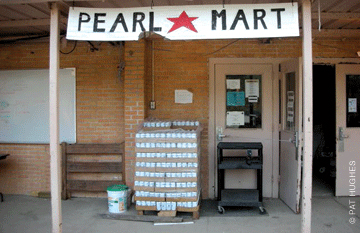
“If there are any volunteers in the congregation, please stand up.”
The Rev. Sebastian Myladiyil was speaking from the pulpit of St. Rose de Lima Catholic Church. Behind him was a mural of a muscular, loincloth-clad Jesus, bathed in light and looking like a dark-skinned Daniel Day-Lewis in The Last of the Mohicans.
Connie Hoe, point person for Penn’s volunteer efforts in Hancock County, Mississippi, had gently suggested that we attend the Palm Sunday service at this multi-racial church in the Katrina-ravaged town of Bay St. Louis, and while I’m not remotely Catholic and my wife could safely be described as lapsed, it was just what we needed. Hoe had emphasized the terrific choir to us, but the Indian-accented Father Myladiyil also delivered a brilliant, soul-firing sermon about the importance of recognizing the sacred in each person. When he asked the volunteers to stand, the applause was long and heartfelt.
That last ritual apparently takes place every Sunday, and it’s not an empty gesture. Without the thousands of volunteers—most of them faith-based—who have put their shoulders to the wheel over the last 32 months, Hancock County would be in far worse shape than it is. Needless to say, that holds true in New Orleans, too.
The uplifting message didn’t translate into immediate enlightenment for our teenage sons Tristan and Jesse—who, shortly after the service, staged a brief, unpleasant rebellion over the terrible indignity of having to sleep in the snore-filled recovery center on their spring vacation and take showers in smelly water and work without pay for people they didn’t know. It soon passed, but they were still on the fence about this whole volunteering business when we went on our first shift of recovery work: installing some bathroom molding in a house whose only occupant that day was a young man who never said a word to us and sat on the couch playing Grand Theft Auto for the three hours we were there. I don’t know if I would call it an epiphany, but I do know that that my sons saw something they didn’t like: that young man’s attitude, and the possibility of themselves that he represented.
That afternoon, we got our next assignment, at the Pearlington house of Joe and Linda Gammage. They were friendly, industrious, and as organized as it is possible to be in a flood-ravaged house with three dogs, a cat, two parrots, and a willful three-year-old granddaughter on the prowl. They also had a sense of humor, which had come in handy when Katrina’s storm surge sent them up into the rafters of their one-story brick house, whose water line was way over our heads. The dogs, Linda informed me between drags on her cigarette, had learned to “refrigerator surf,” which involved balancing on a floating refrigerator.
For the next three days we painted, spackled, stained wood, and dug bricks out of the deep mud where the flowerbed used to be. It was the first volunteer help the Gammages had had since Katrina, and though our contributions looked niggardly when the sheetrock-hanging crew showed up, I can safely say that we did more good than harm.
“Y’all kicked serious butt today, every one of you,” said Joe Gammage with a twinkly grin. By now Tristan and Jesse were muddy, paint-spattered, and tired. They were also feeling a lot better about this trip—and themselves.
Our last morning in Pearlington, the boys got up early, even by recovery-center standards. The thought of New Orleans and the comfortable hotel to which we were headed had such appeal that we didn’t even grab our complimentary bowl of raisin bran on the way out. But we did say goodbye to Bob Putnam and Larry Randall, the volunteer coordinator and co-director, who had organized our projects, taken time out of their day to be interviewed, and shown considerable humor and patience in the midst of hard work and chaos. If you’re looking for heroes, you could do a lot worse than to start there.
Later that day, while Tristan was asserting his independence by wandering around the French Quarter chatting up drunks, Pat and Jesse and I walked over to Basin Street Station, a lavishly restored Southern Railroad station at the corner of Basin and Canal streets that is now a self-proclaimed “cultural center.” Nick Spitzer had just finished taping that week’s “American Routes” on the fourth floor, and after showing us around the studio he took us across the street to St. Louis Cemetery No. 1.
A lot has been written about the city’s oldest necropolis, which has appeared in Interview with the Vampire and Easy Rider and inspired several websites devoted to its history and lore. I won’t claim to have felt the presence of any spirits there, though I was delighted to see that the tomb of Marie Laveau, the Voodoo Queen, was not far from the vault of the mayoral Morials. The otherworldly surroundings, coupled with Spitzer’s erudite riffs, had a tonic effect on us, and we went back to our tourist haunts recharged.
Maybe this is how New Orleans is coming back to life: with strangers coming in to help the living and learn from the dead, to rebuild and re-envision this afflicted, still-magical city. But like the man says, it can’t be done without music.
SIDEBAR
Place Matters
Rebuilding a city is a complicated business. When the city in question is New Orleans—soaked in history, culture, and venality, its variegated neighborhoods ravaged selectively by the floodwaters—it becomes more complicated still. All the good will and money and volunteer sweat equity can’t remake that flawed national treasure in a satisfactory manner unless there’s some solid planning and thoughtful fieldwork behind it. Even then, it won’t be easy.
Enter Penn’s Center for Urban Redevelopment Excellence (CUREx), based in the School of Design. Through the Rockefeller Foundation Redevelopment Fellowship program, CUREx (in conjunction with the University of New Orleans) has planted seeds of renewal in the form of 25 fellows sent to the city’s most important redevelopment organizations. By investing at “strategic points in the redevelopment system”—land, public and private funding, and the capacity to use these resources—the program will yield “more and better housing and community projects,” explained Valerie Piper, CUREx’s executive director.
The fellowships “will allow us to attract the best and brightest urban development professionals, so that the city can accelerate its recovery and rebuilding efforts,” says former Penn President Judith Rodin CW’66 Hon’04—who, as president of the Rockefeller Foundation, had a little something to do with the center and the fellows. In the eyes of Edward Blakely, director of the city’s Office of Recovery Management, the fellowships are “critically important in helping the city build the necessary human capital” to continue its recovery.
This past March, 21 graduate students from Penn’s Department of City and Regional Planning spent a week as Rockefeller-funded interns in New Orleans. Their employers included Neighborhood Housing Services of New Orleans, Providence Community Housing, New Orleans Neighborhood Development Collaborative, and New Orleans Redevelopment Authority (NORA). The interns took on a variety of much-needed tasks: helping to design and organize a master property inventory database and link it to ArcGIS (geographic information system) maps, gathering data for a property database, and developing an implementation plan for a parcel survey, for starters. Their skills and professionalism earned ringing praise, not just from the fellows who supervised them but from people in the neighborhoods.
Mary Itz and Andrea Nair worked under John Marshall, a real-estate lawyer and land-use planning expert who was tapped last fall to serve as a fellow with NORA. His main job has been to assemble parcels of land within Orleans Parish for redevelopment, including lots in the devastated middle-class Lakeview neighborhood near Lake Pontchartrain. The week Itz and Nair arrived, his office had to get a list of properties to the state for approval, and their arrival meant he could tap their data instead of eyeballing vacant lots in Lakeview. “I would have been out there looking at lots, but because they were here, I didn’t have to—this was one of their areas of expertise.”
Sarah Olivier—a Rockefeller fellow with Neighborhood Housing Services of New Orleans whose resume includes stints as a planning consultant and as a housing development manager—worked with 11 CUREx interns. They carried out an extensive, property-by-property survey in the Seventh Ward, a poor but historically significant neighborhood that was hit hard but not knocked out by Katrina, and whose inhabitants have included the likes of Jelly Roll Morton.
“They were just fantastic,” Olivier said of the interns. “I can’t say enough about them.”
After getting trained on using the property-assessment form, Olivier explains, the interns “broke themselves out into survey teams and data-entry teams. And this was completely self-directed. So not only did they survey everything, but they entered all the data. For a small nonprofit, I don’t know when we would have got to this. It would have been completely piecemeal. It would have been me, driving around in my car.”
The CUREx interns also kept journals of their activities, and were kind enough to share them with the Gazette. You can read them here.



